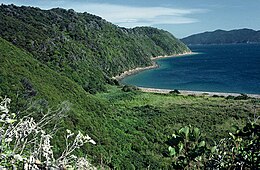 | |
| Geography | |
|---|---|
| Location | Marlborough Region |
| Coordinates | 41°06′49.67″S 174°17′4.32″E / 41.1137972°S 174.2845333°E / -41.1137972; 174.2845333 |
| Area | 1.41 km (0.54 sq mi) |
| Length | 4 km (2.5 mi) |
| Width | 1 km (0.6 mi) |
| Highest elevation | 152 m (499 ft) |
| Administration | |
| Department of Conservation (New Zealand) | |
| Demographics | |
| Population | 0 |
Long Island is located in Queen Charlotte Sound, one of the Marlborough Sounds of New Zealand. James Cook recorded its original name as Hamote.
The island is long and thin - just over 1.41 square kilometres (0.54 sq mi) in area with a length of 4 km (2.5 mi) (the long axis being aligned north-east to south-west) and a maximum width of 1 km (0.62 mi). It was reserved for public utility on 26 March 1926 and soon after became a farm which ran between 300 and 400 sheep until 14 January 1926 when the island became a scenic reserve. With the removal of stock in the 1930s the island has been left to regenerate back into native bush.
In April 1993, the Long Island-Kokomohua Marine reserve was created around Long island and the tiny Kokomohua islands off its northern tip. It extends 460 metres (1,510 ft) offshore from the high water mark around the islands and was the first Marine reserve to be created in the South Island. The island itself is also an important wildlife refuge and a number of species of threatened endemic birds which have been reintroduced to it including little spotted kiwi (late 1980s), yellow-crowned parakeet (2001) and South Island saddleback (2005) - all these reintroductions have been successful with healthy breeding populations of each species now present on the Island.

See also
References
- ^ "Long Island - Kokomohua Marine Reserve". Department of Conservation (New Zealand). Retrieved 4 March 2020.
- "Cook's First Voyage". pacific.pitt.edu. Retrieved 18 January 2022.
- "Wartime relics and spooky submarine stations rediscovered on Sounds voyage". Stuff. 28 November 2019. Retrieved 18 January 2022.
- "Marine Reserve (Long Island—Kokomohua) Order 1993". Parliamentary Council Office. Retrieved 4 March 2020.
- P. D Gaze; Bill Cash (2008). A history of wildlife translocations in the Marlborough Sounds (PDF). Vol. 72. Department of Conservation. pp. 1–25. ISBN 978-0-478-14293-8. ISSN 0113-3853. OCLC 1178912174. Wikidata Q104836742. Archived from the original (PDF) on 22 January 2021.
{{cite book}}:|journal=ignored (help) - "Long Island". www.marlboroughonline.co.nz. Retrieved 18 January 2022.
| Marlborough District, New Zealand | |||||||
|---|---|---|---|---|---|---|---|
| Seat: Blenheim | |||||||
| Populated places |
| ||||||
| Geographic features | |||||||
| Facilities and attractions | |||||||
| Government | |||||||
| Iwi | |||||||
| Queen Charlotte Sound / Tōtaranui, New Zealand | |||||||||||||||||||||
|---|---|---|---|---|---|---|---|---|---|---|---|---|---|---|---|---|---|---|---|---|---|
| Bays and coves |
| ||||||||||||||||||||
| Islands | |||||||||||||||||||||
| Points and heads |
| ||||||||||||||||||||
| Rocks | |||||||||||||||||||||
41°06′49.67″S 174°17′4.32″E / 41.1137972°S 174.2845333°E / -41.1137972; 174.2845333
This Marlborough Region-related geography article is a stub. You can help Misplaced Pages by expanding it. |